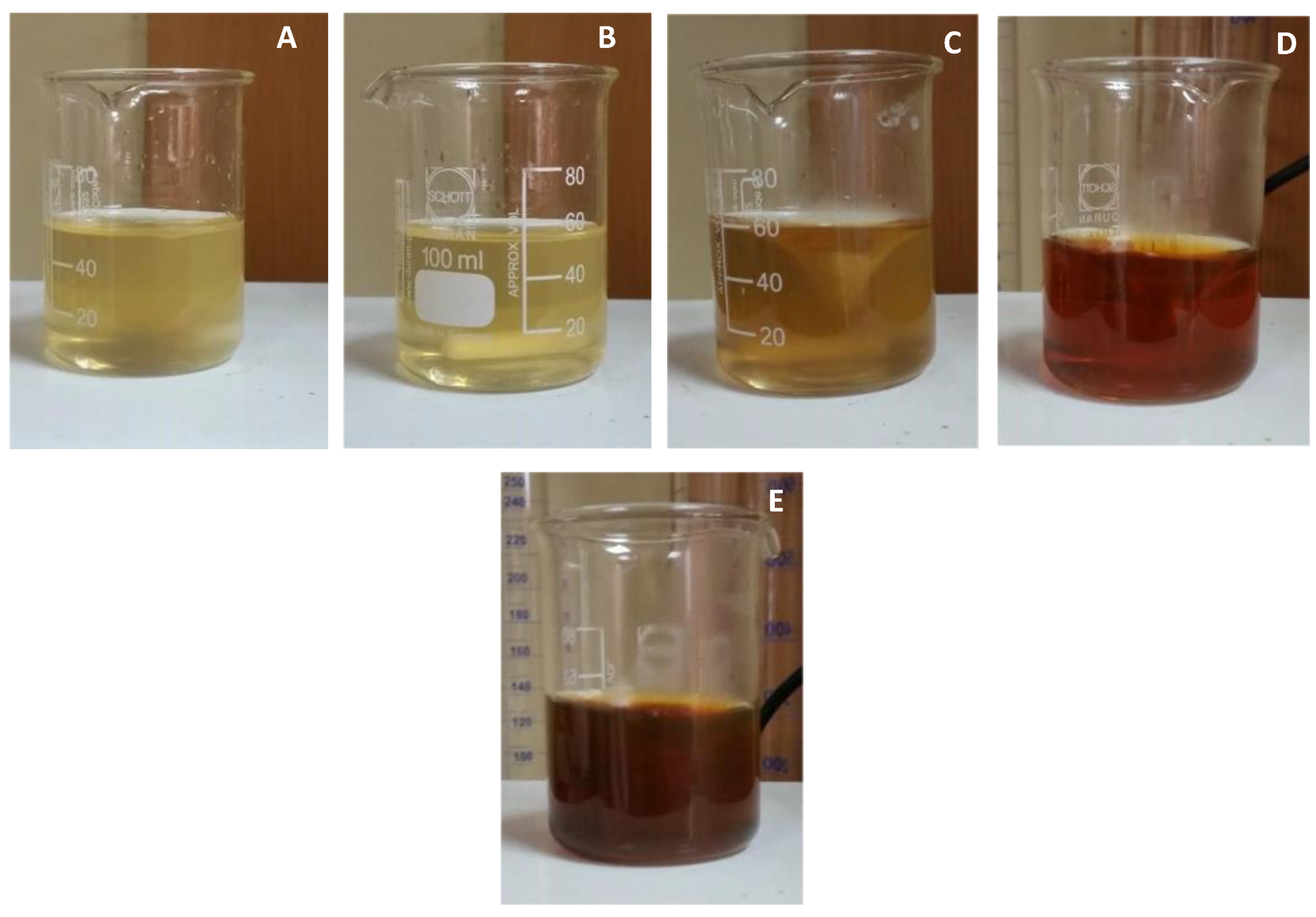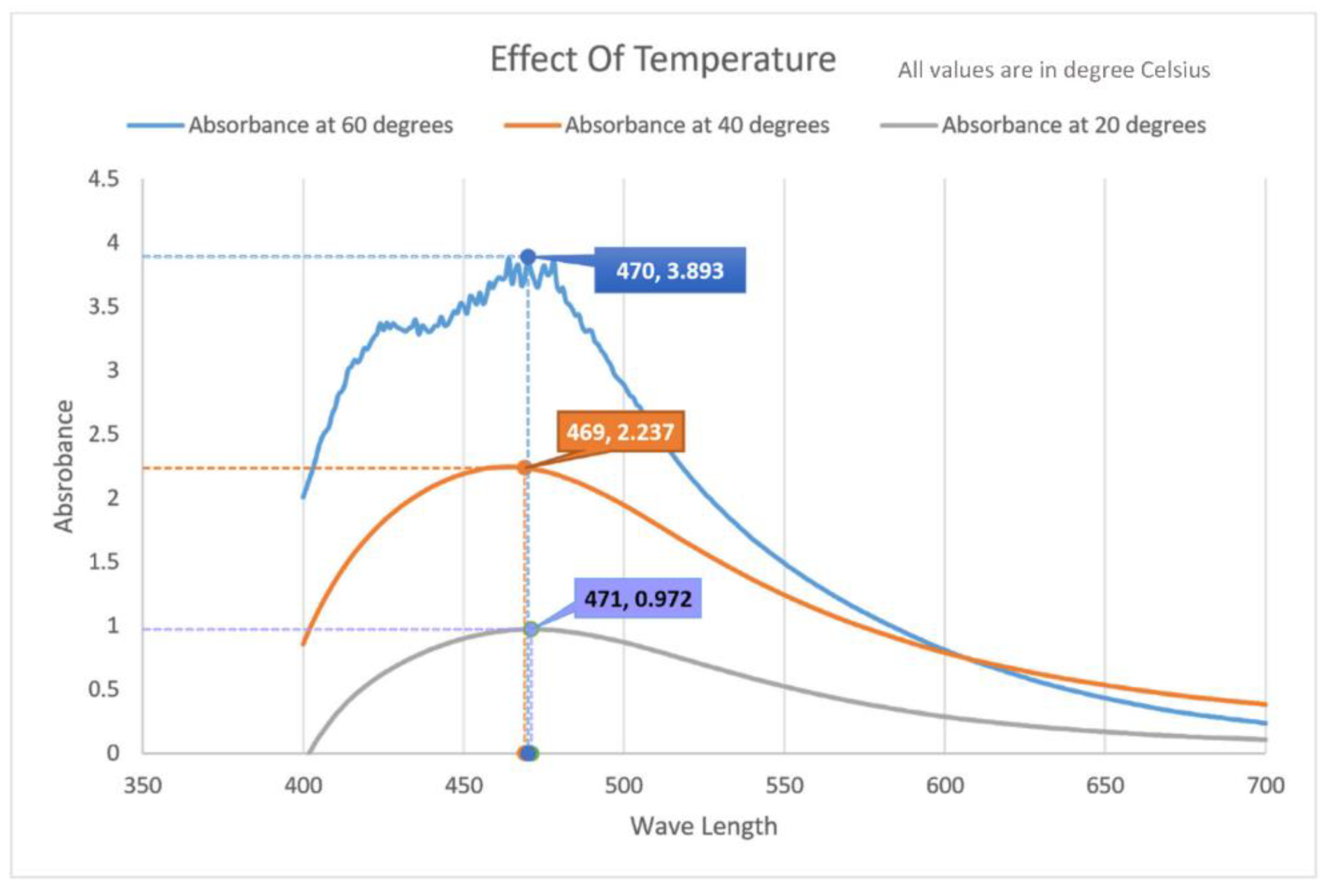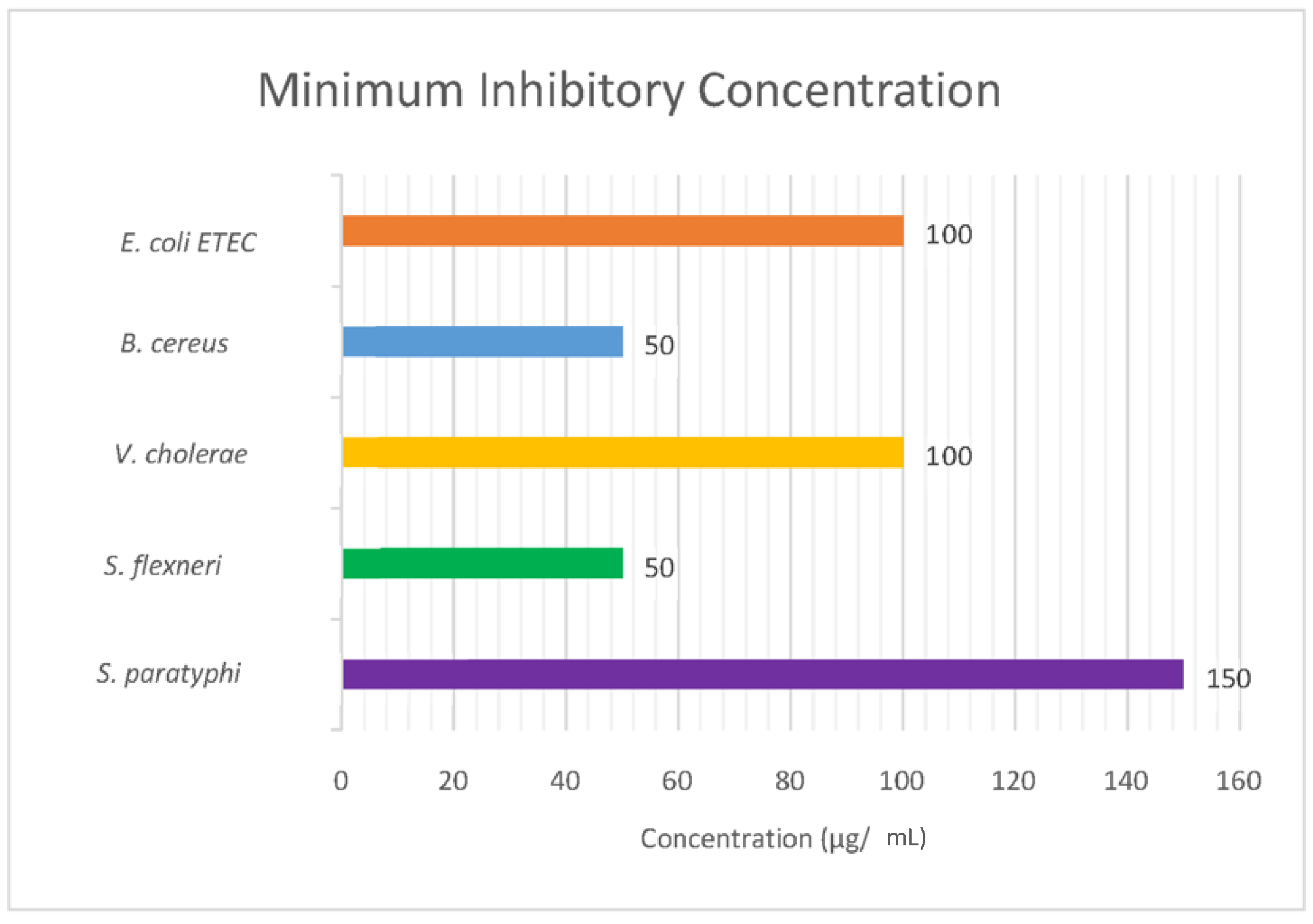Biosynthesis of Silver Nanoparticles from Cymbopogon citratus Leaf Extract and Evaluation of Their Antimicrobial Properties
Abstract
:1. Background
1.1. Synthesis of Plant Nanoparticles
1.2. Selection of Plant Extract
1.3. Naturally Derived Materials and Plant Extracts Provide Solutions for Global Challenges
1.4. Objectives of This Study
2. Methods
2.1. Collection and Preparation of Plant Extract
2.2. Synthesis of Silver Nanoparticles with Aqueous Extract of C. citratus
2.3. Characterization of the Silver Nanoparticles
2.3.1. UV–Visible Spectrometric Analysis
2.3.2. Size Estimation of AgNPs
2.4. Antibacterial Assays
2.4.1. Bacterial Strain Collection
2.4.2. Agar Well Diffusion Method
2.4.3. Minimum Inhibitory Concentration (MIC)
3. Results
3.1. Synthesis of Silver Nanoparticles
3.2. Surface Plasmon Resonance (SPR) Analysis
3.3. Analyzing the Effect of Temperature
3.4. Effect of pH on the Formation of Silver Nanoparticles
3.5. Effect of Plant Extract Volume
3.6. Estimating the Size of the Silver Nanoparticles
3.7. Stability of the Silver Nanoparticles
3.8. Antibacterial Assays
3.8.1. Results of Agar Well Diffusion
3.8.2. Results of Minimum Inhibitory Concentration Test
4. Discussion
5. Conclusions
Author Contributions
Funding
Institutional Review Board Statement
Informed Consent Statement
Data Availability Statement
Conflicts of Interest
References
- Sharma, G.; Jasuja, N.D.; Kumar, M.; Ali, M.I. Biological Synthesis of Silver Nanoparticles by Cell-Free Extract of Spirulina Platensis. J. Nanotechnol. 2015, 2015, 1–6. [Google Scholar] [CrossRef] [Green Version]
- Ivanova, N.; Gugleva, V.; Dobreva, M.; Pehlivanov, I.; Stefanov, S.; Andonova, V. Silver Nanoparticles as Multi-Functional Drug Delivery Systems. In Nanomedicines; Akhyar Farrukh, M., Ed.; IntechOpen: London, UK, 2019; ISBN 978-1-78985-283-7. [Google Scholar]
- Prabhu, S.; Poulose, E.K. Silver Nanoparticles: Mechanism of Antimicrobial Action, Synthesis, Medical Applications, and Toxicity Effects. Int. Nano Lett. 2012, 2, 32. [Google Scholar] [CrossRef] [Green Version]
- Venkataramana, B.; Sankar, S.S.; Kumar, A.S.; Naidu, B.V.K. Synthesis of Silver Nanoparticles Using Setaria Italica (Foxtail Millets) Husk and Its Antimicrobial Activity. Res. J. Nanosci. Nanotechnol. 2015, 5, 6–15. [Google Scholar] [CrossRef]
- Munteanu, A.; Florescu, I.P.; Nitescu, C. A Modern Method of Treatment: The Role of Silver Dressings in Promoting Healing and Preventing Pathological Scarring in Patients with Burn Wounds. J. Med. Life 2016, 9, 306–315. [Google Scholar] [PubMed]
- Sim, W.; Barnard, R.T.; Blaskovich, M.A.T.; Ziora, Z.M. Antimicrobial Silver in Medicinal and Consumer Applications: A Patent Review of the Past Decade (2007–2017). Antibiotics 2018, 7, e93. [Google Scholar] [CrossRef] [Green Version]
- Jain, S.; Mehata, M.S. Medicinal Plant Leaf Extract and Pure Flavonoid Mediated Green Synthesis of Silver Nanoparticles and Their Enhanced Antibacterial Property. Sci. Rep. 2017, 7, 15867. [Google Scholar] [CrossRef]
- Popescu, M.; Velea, A. Biogenic Production of Nanoparticles. Dig. J. Nanomater. Biostruct. 2010, 6, 1035–1040. [Google Scholar]
- Baruwati, B.; Polshettiwar, V.; Varma, R.S. Glutathione Promoted Expeditious Green Synthesis of Silver Nanoparticles in Water Using Microwaves. Green Chem. 2009, 11, 926. [Google Scholar] [CrossRef]
- Yin, I.X.; Zhang, J.; Zhao, I.S.; Mei, M.L.; Li, Q.; Chu, C.H. The Antibacterial Mechanism of Silver Nanoparticles and Its Application in Dentistry. Int. J. Nanomed. 2020, 15, 2555–2562. [Google Scholar] [CrossRef] [Green Version]
- Mikhailova, E.O. Silver Nanoparticles: Mechanism of Action and Probable Bio-Application. J. Funct. Biomater. 2020, 11, e84. [Google Scholar] [CrossRef]
- Goswami, G.; Boruah, H.; Gautom, T.; Hazarika, D.J.; Barooah, M.; Boro, R.C. Chemically Synthesized Silver Nanoparticles as Cell Lysis Agent for Bacterial Genomic DNA Isolation. Adv. Nat. Sci. Nanosci. Nanotechnol. 2017, 8, 045015. [Google Scholar] [CrossRef] [Green Version]
- Feng, Q.L.; Wu, J.; Chen, G.Q.; Cui, F.Z.; Kim, T.N.; Kim, J.O. A Mechanistic Study of the Antibacterial Effect of Silver Ions on Escherichia Coli and Staphylococcus Aureus. J. Biomed. Mater. Res. 2000, 52, 662–668. [Google Scholar] [CrossRef]
- Xu, H.; Qu, F.; Xu, H.; Lai, W.; Andrew Wang, Y.; Aguilar, Z.P.; Wei, H. Role of Reactive Oxygen Species in the Antibacterial Mechanism of Silver Nanoparticles on Escherichia Coli O157:H7. Biometals 2012, 25, 45–53. [Google Scholar] [CrossRef] [PubMed]
- Gudikandula, K.; Charya Maringanti, S. Synthesis of Silver Nanoparticles by Chemical and Biological Methods and Their Antimicrobial Properties. J. Exp. Nanosci. 2016, 11, 714–721. [Google Scholar] [CrossRef]
- Natsuki, J.; Natsuki, T.; Hashimoto, Y. A Review of Silver Nanoparticles: Synthesis Methods, Properties and Applications. Int. J. Mater. Sci. Appl. 2015, 4, 325. [Google Scholar] [CrossRef]
- Ebrahiminezhad, A.; Bagheri, M.; Taghizadeh, S.-M.; Berenjian, A.; Ghasemi, Y. Biomimetic Synthesis of Silver Nanoparticles Using Microalgal Secretory Carbohydrates as a Novel Anticancer and Antimicrobial. Adv. Nat. Sci. Nanosci. Nanotechnol. 2016, 7, 015018. [Google Scholar] [CrossRef]
- Shaik, M.; Khan, M.; Kuniyil, M.; Al-Warthan, A.; Alkhathlan, H.; Siddiqui, M.; Shaik, J.; Ahamed, A.; Mahmood, A.; Khan, M.; et al. Plant-Extract-Assisted Green Synthesis of Silver Nanoparticles Using Origanum Vulgare L. Extract and Their Microbicidal Activities. Sustainability 2018, 10, 913. [Google Scholar] [CrossRef] [Green Version]
- Gavade, S.J.M.; Nikam, G.H.; Dhabbe, R.S.; Sabale, S.R.; Tamhankar, B.V.; Mulik, G.N. Green Synthesis of Silver Nanoparticles by Using Carambola Fruit Extract and Their Antibacterial Activity. Adv. Nat. Sci. 2015, 6, 045015. [Google Scholar] [CrossRef]
- Khatoon, N.; Mazumder, J.A.; Sardar, M. Biotechnological Applications of Green Synthesized Silver Nanoparticles. J. Nanosci. Curr. Res. 2017, 2, 107. [Google Scholar] [CrossRef]
- Jain, D.; Daima, H.K.; Kachhwaha, S.; Kothari, S.L. Synthesis of Plant-Mediated Silver Nanoparticles Using Papaya Fruit Extract and Evaluation of their Anti Microbial Activities. Dig. J. Nanomater. Biostruct. 2009, 7, 557–563. [Google Scholar]
- Vokou, D.; Kokkini, S.; Bessiere, J.-M. Geographic Variation of Greek Oregano (Origanum Vulgare Ssp. Hirtum) Essential Oils. Biochem. Syst. Ecol. 1993, 21, 287–295. [Google Scholar] [CrossRef]
- Chukwuocha, U.M.; Fernández-Rivera, O.; Legorreta-Herrera, M. Exploring the Antimalarial Potential of Whole Cymbopogon Citratus Plant Therapy. J. Ethnopharmacol. 2016, 193, 517–523. [Google Scholar] [CrossRef] [PubMed]
- Umar, M.; Mohammed, I.; Oko, J.; Tafinta, I.; Aliko, A.; Jobbi, D. Phytochemical Analysis and Antimicrobial Effect of Lemon Grass (Cymbopogon Citratus) Obtained from Zaria, Kaduna State, Nigeria. J. Complementary Altern. Med. Res. 2016, 1, 1–8. [Google Scholar] [CrossRef]
- Rakib-Uz-Zaman, S.M.; Iqbal, A.; Mowna, S.A.; Khanom, M.G.; Al Amin, M.M.; Khan, K. Ethnobotanical Study and Phytochemical Profiling of Heptapleurum Hypoleucum Leaf Extract and Evaluation of Its Antimicrobial Activities against Diarrhea-Causing Bacteria. J. Genet. Eng. Biotechnol. 2020, 18, 18. [Google Scholar] [CrossRef]
- Ashammakhi, N.; GhavamiNejad, A.; Tutar, R.; Fricker, A.; Roy, I.; Chatzistavrou, X.; Apu, E.H.; Nguyen, K.-L.; Ahsan, T.; Pountos, I.; et al. Highlights on Advancing Frontiers in Tissue Engineering. Tissue Eng. Part B Rev. 2021. [Google Scholar] [CrossRef] [PubMed]
- Ashammakhi, N.; Hernandez, A.L.; Unluturk, B.D.; Quintero, S.A.; de Barros, N.R.; Hoque Apu, E.; Bin Shams, A.; Ostrovidov, S.; Li, J.; Contag, C.; et al. Biodegradable Implantable Sensors: Materials Design, Fabrication, and Applications. Adv. Funct. Mater. 2021, 31, 2104149. [Google Scholar] [CrossRef]
- Ashammakhi, N.; Hoque Apu, E.; Caterson, E.J. Self-Healing Biomaterials to Heal Tissues. J. Craniofacial Surg. 2021, 32, 819–820. [Google Scholar] [CrossRef] [PubMed]
- Hoque Apu, E.; Akram, S.U.; Rissanen, J.; Wan, H.; Salo, T. Desmoglein 3–Influence on Oral Carcinoma Cell Migration and Invasion. Exp. Cell Res. 2018, 370, 353–364. [Google Scholar] [CrossRef] [PubMed]
- Salo, T.; Sutinen, M.; Hoque Apu, E.; Sundquist, E.; Cervigne, N.K.; de Oliveira, C.E.; Akram, S.U.; Ohlmeier, S.; Suomi, F.; Eklund, L.; et al. A Novel Human Leiomyoma Tissue Derived Matrix for Cell Culture Studies. BMC Cancer 2015, 15, 981. [Google Scholar] [CrossRef] [PubMed] [Green Version]
- Yee, N.S.; Ignatenko, N.; Finnberg, N.; Lee, N.; Stairs, D. ANIMAL MODELS OF CANCER BIOLOGY. Cancer Growth Metastasis 2015, 8, 115–118. [Google Scholar] [CrossRef] [Green Version]
- Devaux, C.A.; Mediannikov, O.; Medkour, H.; Raoult, D. Infectious Disease Risk Across the Growing Human-Non Human Primate Interface: A Review of the Evidence. Front. Public Health 2019, 7, 305. [Google Scholar] [CrossRef] [PubMed] [Green Version]
- Kaiser, J. Animal Models. Advisers Urge NIH to Scale Back Chimpanzee Research. Science 2013, 339, 501. [Google Scholar] [CrossRef] [PubMed]
- National Institutes of Health (NIH). NIH to Reduce Significantly the Use of Chimpanzees in Research. Available online: https://www.nih.gov/news-events/news-releases/nih-reduce-significantly-use-chimpanzees-research (accessed on 31 March 2022).
- Smietana, K.; Siatkowski, M.; Møller, M. Trends in Clinical Success Rates. Nat. Rev. Drug Discov. 2016, 15, 379–380. [Google Scholar] [CrossRef] [PubMed]
- Oladeji, O.S.; Adelowo, F.E.; Ayodele, D.T.; Odelade, K.A. Phytochemistry and Pharmacological Activities of Cymbopogon Citratus: A Review. Sci. Afr. 2019, 6, e00137. [Google Scholar] [CrossRef]
- Ajayi, E.; Afolayan, A. Green Synthesis, Characterization and Biological Activities of Silver Nanoparticles from Alkalinized Cymbopogon Citratus Stapf. Adv. Nat. Sci. Nanosci. Nanotechnol. 2017, 8, 015017. [Google Scholar] [CrossRef]
- Amendola, V.; Bakr, O.M.; Stellacci, F. A Study of the Surface Plasmon Resonance of Silver Nanoparticles by the Discrete Dipole Approximation Method: Effect of Shape, Size, Structure, and Assembly. Plasmonics 2010, 5, 85–97. [Google Scholar] [CrossRef]
- Muntasir, M.N. Rapid Biological Synthesis of Silver Nanoparticles from Cymbopogon Citratus Extract and Evaluation of Its Antimicrobial Properties. Bachelor’s Thesis, BRAC University, Dhaka, Bangladesh, 2018. [Google Scholar]
- Khalil, M.A.; El Maghraby, G.M.; Sonbol, F.I.; Allam, N.G.; Ateya, P.S.; Ali, S.S. Enhanced Efficacy of Some Antibiotics in Presence of Silver Nanoparticles Against Multidrug Resistant Pseudomonas Aeruginosa Recovered from Burn Wound Infections. Front. Microbiol. 2021, 12, 648560. [Google Scholar] [CrossRef]
- Ajani, O.O.; Owoeye, T.F.; Olasehinde, G.I.; Akinlabu, D.K.; Owolabi, F.E.; Audu, O.Y. Characterization, Proximate Composition and Evaluation of Antimicrobial Activity of Seed Oil of Bauhinia Tomentosa. J. Biol. Sci. 2016, 16, 102–111. [Google Scholar] [CrossRef] [Green Version]
- Długosz, O.; Banach, M. Continuous Production of Silver Nanoparticles and Process Control. J. Clust. Sci. 2019, 30, 541–552. [Google Scholar] [CrossRef] [Green Version]
- Shankar, S.S.; Rai, A.; Ahmad, A.; Sastry, M. Rapid Synthesis of Au, Ag, and Bimetallic Au Core-Ag Shell Nanoparticles Using Neem (Azadirachta Indica) Leaf Broth. J. Colloid. Interface. Sci. 2004, 275, 496–502. [Google Scholar] [CrossRef]
- Shams, S.; Khan, A.U.; Yuan, Q.; Ahmad, W.; Wei, Y.; Khan, Z.U.H.; Shams, S.; Ahmad, A.; Rahman, A.U.; Ullah, S. Facile and Eco-Benign Synthesis of Au@Fe2O3 Nanocomposite: Efficient Photocatalytic, Antibacterial and Antioxidant Agent. J. Photochem. Photobiol. B. Biol. 2019, 199, 111632. [Google Scholar] [CrossRef] [PubMed]
- Khan, Z.U.H.; Shah, N.S.; Iqbal, J.; Khan, A.U.; Imran, M.; Alshehri, S.M.; Muhammad, N.; Sayed, M.; Ahmad, N.; Kousar, A.; et al. Biomedical and Photocatalytic Applications of Biosynthesized Silver Nanoparticles: Ecotoxicology Study of Brilliant Green Dye and Its Mechanistic Degradation Pathways. J. Mol. Liq. 2020, 319, 114114. [Google Scholar] [CrossRef]
- Ahmad, W.; Khan, A.U.; Shams, S.; Qin, L.; Yuan, Q.; Ahmad, A.; Wei, Y.; Khan, Z.U.H.; Ullah, S.; Rahman, A.U. Eco-Benign Approach to Synthesize Spherical Iron Oxide Nanoparticles: A New Insight in Photocatalytic and Biomedical Applications. J. Photochem. Photobiol. B. Biol. 2020, 205, 111821. [Google Scholar] [CrossRef] [PubMed]
- Ibrahim, H.M.M. Green Synthesis and Characterization of Silver Nanoparticles Using Banana Peel Extract and Their Antimicrobial Activity against Representative Microorganisms. J. Radiat. Res. Appl. Sci. 2015, 8, 265–275. [Google Scholar] [CrossRef] [Green Version]
- Verma, A.; Mehata, M.S. Controllable Synthesis of Silver Nanoparticles Using Neem Leaves and Their Antimicrobial Activity. J. Radiat. Res. Appl. Sci. 2016, 9, 109–115. [Google Scholar] [CrossRef] [Green Version]
- Alqadi, M.K.; Abo Noqtah, O.A.; Alzoubi, F.Y.; Alzouby, J.; Aljarrah, K. PH Effect on the Aggregation of Silver Nanoparticles Synthesized by Chemical Reduction. Mater. Sci.-Pol. 2014, 32, 107–111. [Google Scholar] [CrossRef]
- Dubey, S.P.; Lahtinen, M.; Sillanpää, M. Tansy Fruit Mediated Greener Synthesis of Silver and Gold Nanoparticles. Process Biochem. 2010, 45, 1065–1071. [Google Scholar] [CrossRef]
- Gosens, I.; Post, J.A.; de la Fonteyne, L.J.; Jansen, E.H.; Geus, J.W.; Cassee, F.R.; de Jong, W.H. Impact of Agglomeration State of Nano- and Submicron Sized Gold Particles on Pulmonary Inflammation. Part. Fibre Toxicol. 2010, 7, 37. [Google Scholar] [CrossRef] [Green Version]
- Šileikaitė, A.; Puiso, J.; Prosycevas, I.; Tamulevičius, S. Investigation of Silver Nanoparticles Formation Kinetics During Reduction of Silver Nitrate with Sodium Citrate. Medziagotyra 2009, 15, 21–27. [Google Scholar]
- Khan, A.U.; Wei, Y.; Khan, Z.U.H.; Tahir, K.; Khan, S.U.; Ahmad, A.; Khan, F.U.; Cheng, L.; Yuan, Q. Electrochemical and Antioxidant Properties of Biogenic Silver Nanoparticles. Int. J. Electrochem. Sci. 2015, 10, 12. [Google Scholar]
- Sondi, I.; Salopek-Sondi, B. Silver Nanoparticles as Antimicrobial Agent: A Case Study on E. Coli as a Model for Gram-Negative Bacteria. J. Colloid Interface Sci. 2004, 275, 177–182. [Google Scholar] [CrossRef]
- Shameli, K.; Ahmad, M.B.; Jazayeri, S.D.; Shabanzadeh, P.; Sangpour, P.; Jahangirian, H.; Gharayebi, Y. Investigation of Antibacterial Properties Silver Nanoparticles Prepared via Green Method. Chem. Cent. J. 2012, 6, 73. [Google Scholar] [CrossRef] [PubMed] [Green Version]
- Liao, S.; Zhang, Y.; Pan, X.; Zhu, F.; Jiang, C.; Liu, Q.; Cheng, Z.; Dai, G.; Wu, G.; Wang, L.; et al. Antibacterial Activity and Mechanism of Silver Nanoparticles against Multidrug-Resistant Pseudomonas Aeruginosa. Int. J. Nanomed. 2019, 14, 1469–1487. [Google Scholar] [CrossRef] [PubMed] [Green Version]
- Gonelimali, F.D.; Lin, J.; Miao, W.; Xuan, J.; Charles, F.; Chen, M.; Hatab, S.R. Antimicrobial Properties and Mechanism of Action of Some Plant Extracts Against Food Pathogens and Spoilage Microorganisms. Front. Microbiol. 2018, 9, 1639. [Google Scholar] [CrossRef] [PubMed]
- Hano, C.; Abbasi, B.H. Plant-Based Green Synthesis of Nanoparticles: Production, Characterization and Applications. Biomolecules 2021, 12, 31. [Google Scholar] [CrossRef]
- Bhardwaj, B.; Singh, P.; Kumar, A.; Kumar, S.; Budhwar, V. Eco-Friendly Greener Synthesis of Nanoparticles. Adv. Pharm. Bull. 2020, 10, 566–576. [Google Scholar] [CrossRef]
- Rendón-Villalobos, R.; Ortíz-Sánchez, A.; Tovar-Sánchez, E.; Flores-Huicochea, E. The Role of Biopolymers in Obtaining Environmentally Friendly Materials. In Composites from Renewable and Sustainable Materials; Poletto, M., Ed.; InTech: London, UK, 2016; ISBN 978-953-51-2793-2. [Google Scholar]
- Zhang, X.-F.; Liu, Z.-G.; Shen, W.; Gurunathan, S. Silver Nanoparticles: Synthesis, Characterization, Properties, Applications, and Therapeutic Approaches. Int. J. Mol. Sci. 2016, 17, E1534. [Google Scholar] [CrossRef]








| Organism | AgNO3 | Plant Extract | Nanoparticles | Plant Extract and Nanoparticles |
|---|---|---|---|---|
| S. paratyphi | 11 | 0 | 11.5 | 12 |
| S. flexneri | 11 | 0 | 12 | 13 |
| V. cholerae | 13 | 0 | 13 | 14 |
| B. cereus | 11 | 0 | 10 | 11 |
| E. coli (ETEC) | 11.5 | 0 | 11.5 | 12 |
Publisher’s Note: MDPI stays neutral with regard to jurisdictional claims in published maps and institutional affiliations. |
© 2022 by the authors. Licensee MDPI, Basel, Switzerland. This article is an open access article distributed under the terms and conditions of the Creative Commons Attribution (CC BY) license (https://creativecommons.org/licenses/by/4.0/).
Share and Cite
Rakib-Uz-Zaman, S.M.; Hoque Apu, E.; Muntasir, M.N.; Mowna, S.A.; Khanom, M.G.; Jahan, S.S.; Akter, N.; R. Khan, M.A.; Shuborna, N.S.; Shams, S.M.; et al. Biosynthesis of Silver Nanoparticles from Cymbopogon citratus Leaf Extract and Evaluation of Their Antimicrobial Properties. Challenges 2022, 13, 18. https://doi.org/10.3390/challe13010018
Rakib-Uz-Zaman SM, Hoque Apu E, Muntasir MN, Mowna SA, Khanom MG, Jahan SS, Akter N, R. Khan MA, Shuborna NS, Shams SM, et al. Biosynthesis of Silver Nanoparticles from Cymbopogon citratus Leaf Extract and Evaluation of Their Antimicrobial Properties. Challenges. 2022; 13(1):18. https://doi.org/10.3390/challe13010018
Chicago/Turabian StyleRakib-Uz-Zaman, S M, Ehsanul Hoque Apu, Mohammed Nimeree Muntasir, Sadrina Afrin Mowna, Mst Gitika Khanom, Shah Saif Jahan, Nahid Akter, M. Azizur R. Khan, Nadia Sultana Shuborna, Shahriar Mohd Shams, and et al. 2022. "Biosynthesis of Silver Nanoparticles from Cymbopogon citratus Leaf Extract and Evaluation of Their Antimicrobial Properties" Challenges 13, no. 1: 18. https://doi.org/10.3390/challe13010018






